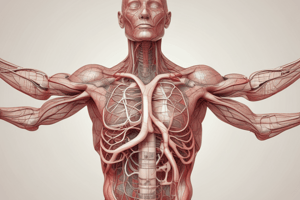Podcast
Questions and Answers
What is the primary function of the circulatory system?
What is the primary function of the circulatory system?
- To carry blood and lymph to and from the tissues of the body (correct)
- To produce blood cells
- To filter waste from the blood
- To regulate body temperature
Which of the following is NOT a part of the Cardiovascular system?
Which of the following is NOT a part of the Cardiovascular system?
- Heart
- Vessels
- Lymph nodes (correct)
- Blood
What is the primary function of Arteries?
What is the primary function of Arteries?
- To carry blood away from the heart (correct)
- To carry blood towards the heart
- To exchange oxygen and nutrients with the tissues
- To filter waste from the blood
What is the smallest type of blood vessel?
What is the smallest type of blood vessel?
What is the outermost layer of the circulatory system?
What is the outermost layer of the circulatory system?
What is the function of the Internal Elastic Lamina?
What is the function of the Internal Elastic Lamina?
What is present in the tunica media?
What is present in the tunica media?
What separates the tunica media from the tunica externa?
What separates the tunica media from the tunica externa?
What is the primary function of postcapillary venules?
What is the primary function of postcapillary venules?
What is the characteristic of tunica externa in medium-sized veins?
What is the characteristic of tunica externa in medium-sized veins?
What is the purpose of vein valves?
What is the purpose of vein valves?
What is a characteristic of large veins?
What is a characteristic of large veins?
What is a key difference between arteries and veins?
What is a key difference between arteries and veins?
What is a characteristic of muscular venules?
What is a characteristic of muscular venules?
What is a feature of the tunica intima in vein valves?
What is a feature of the tunica intima in vein valves?
What is a characteristic of collapsed arteries?
What is a characteristic of collapsed arteries?
What is the main component of the tunica externa?
What is the main component of the tunica externa?
What is the function of the vasa vasorum?
What is the function of the vasa vasorum?
What is the characteristic of capillaries that allows for rapid exchange of substances?
What is the characteristic of capillaries that allows for rapid exchange of substances?
Which type of capillary is found in the central nervous system and thymus?
Which type of capillary is found in the central nervous system and thymus?
What is the characteristic of fenestrated capillaries?
What is the characteristic of fenestrated capillaries?
What is the function of sinusoids?
What is the function of sinusoids?
What is the function of arteriovenous anastomoses?
What is the function of arteriovenous anastomoses?
What is the characteristic of elastic arteries?
What is the characteristic of elastic arteries?
What is the characteristic of muscular arteries?
What is the characteristic of muscular arteries?
What is the function of veins?
What is the function of veins?
Flashcards are hidden until you start studying
Study Notes
The Circulatory System
- The circulatory system is a transport system that carries blood and lymph to and from the tissues of the body.
Cardiovascular System
- The cardiovascular system includes the heart and vessels.
Classes of Blood Vessels
- Arteries: carry blood away from the heart.
- Arterioles: smallest branches of arteries.
- Capillaries: smallest blood vessels, allow exchange between blood and interstitial fluid.
- Venules: collect blood from capillaries.
- Veins: return blood to the heart.
Common Structure of Blood Vessels
- The wall of blood vessels consists of three layers: tunica intima, tunica media, and tunica externa (adventitia).
Tunica Intima
- Innermost layer, includes endothelial lining and connective tissue layer (subendothelial).
- Some vessels have an internal elastic lamina.
Tunica Media
- Middle layer, contains smooth muscle and connective tissue with elastic and reticular fibers.
- External elastic lamina separates tunica media from tunica externa in some vessels.
Tunica Externa
- Outer layer, composed of connective tissue sheath with collagen and elastic fibers.
Vasa Vasorum
- System of vessels that supplies blood to the vascular walls themselves.
Capillaries
- Smallest blood vessels, have small diameter and thin walls.
- Allow exchange of chemicals and gases through diffusion.
- No tunica media and externa, only endothelial cells and basal lamina.
Types of Capillaries
- Continuous: found in most tissues, have restricted permeability.
- Fenestrated: have pores in endothelial lining, allow rapid exchange of water and solutes.
- Discontinuous (Sinusoids): have a large diameter, allow free exchange of water and plasma proteins.
Arteriovenous Anastomoses
- Direct connections between arterioles and venules.
- Bypass the capillary bed, found in skeletal muscle and skin.
Artery Characteristics
- Elastic arteries: large vessels with many elastic fibers and few muscle cells.
- Muscular arteries: medium-sized vessels with many muscle cells.
- Arterioles: small vessels with little or no tunica externa and thin tunica media.
Veins
- Collect blood from capillaries and return it to the heart.
- Have three categories based on size: small veins (venules), medium-sized veins, and large veins.
- Vein valves prevent blood from flowing backward.
Vein Valves
- Folds of tunica intima covered with endothelium, prevent blood from flowing backward.
Studying That Suits You
Use AI to generate personalized quizzes and flashcards to suit your learning preferences.




